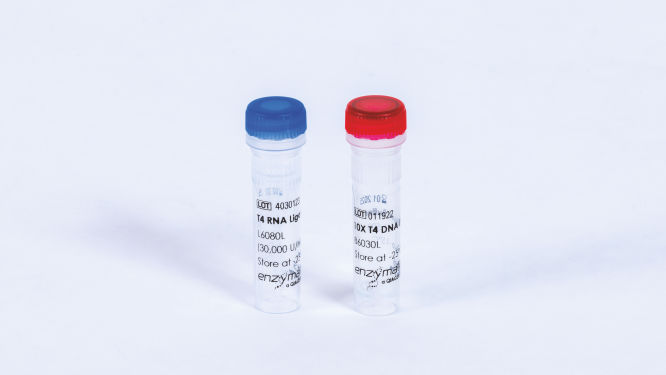Cat. No. / ID: L6080L
Features
- Ligates nicks on double-stranded RNA
- Ligates 5ʹ phosphate and 3ʹ hydroxyl of RNA
Product Details
T4 RNA Ligase 2 catalyzes phosphodiester bond formation between a 5’ phosphate and 3’ hydroxyl termini of RNA. The preferred substrate is nicked double-stranded RNA, but other nicked nucleic acid hybrids can also be sealed. T4 RNA ligase 2 requires ATP for activity unless the substrate is pre-adenylated on the 5’ end (1-5).
Supplied in:
10 mM Tris-HCl, 100 mM NaCl, 0.1 mM DTT, 0.1 mM EDTA, 50% glycerol (pH 7.5 at 25°C)
Supplied with:
10X Ligation Buffer (B6030): 500 mM Tris-HCl, 100 mM MgCl2, 50 mM DTT, 10 mM ATP (pH 7.6 at 25°C)
Performance
- Storage temperature: –25°C to –15°C
- Molecular weight: 37.6 kDa
| Test | Amount tested | Specification |
|---|---|---|
| Purity | n/a | >99% |
| Specific activity | 500 U | >120,000 U/mg |
| Single-stranded exonuclease | 500 U | <5.0 % released |
| Double-stranded exonuclease | 500 U | <1.0 % released |
| Double-stranded endonuclease | 500 U | No conversion |
| E. coli DNA contamination | 500 U | <10 copies |
| RNase contamination | 500 U | No detectable non-specific RNase |
Principle
The enzyme is purified from a strain of E. coli that expresses the recombinant T4 RNA Ligase 2 gene.
One unit is defined as the amount of enzyme required to ligate 50% of 0.4 µg of an equimolar mix of a single-stranded 5’ FAM-labeled 17-mer RNA to the 5’ phosphorylated end of an 18-mer DNA when both strands are annealed to a complementary 35-mer DNA strand in 20 µL at 37°C for 30 minutes.
Procedure
Usage instructions
Nick ligation in double-stranded RNA
- Set up the following reaction mixture in a total volume of 20 µL:
Components Final Concentration Volume Nuclease-free water N/A X µL 10X T4 RNA Ligase Buffer (B6030) 1X 2 µL Nicked dsRNA substrate 1 µM X µL T4 RNA Ligase 2 (L6080L) 10 U 0.33 µL Total Volume = 20 µL - Incubate at 25°C for 60 minutes.
- Reaction can be stopped by adding EDTA and incubating at 65°C for 20 minutes or clean-up using a spin column-based method.
Quality control
Unit activity is measured using a 2-fold serial dilution method. Dilutions of the enzyme were made in 1X reaction buffer, and 2 µL of each enzyme dilution was added to 18 µL reactions in 1X reaction buffer containing 0.4 µg of an equimolar mix of one 17 base RNA oligonucleotide (5’ FAM-labeled) and one 18 base DNA oligonucleotide (5’ phosphorylated) annealed to a complementary 35-mer DNA oligonucleotide. Reactions were incubated for 30 minutes at 37°C, quenched and analyzed on a 15% TBE-Urea gel.
Protein concentration (OD280) is determined by OD280 absorbance.
Physical purity is evaluated by SDS-PAGE of concentrated and diluted enzyme solutions followed by silver stain detection. Purity is assessed by comparing the aggregate mass of contaminant bands in the concentrated sample to the mass of the protein of interest band in the diluted sample.
Single-stranded exonuclease is determined in a 50 µL reaction containing a radiolabeled single-stranded DNA substrate and 10 µL of enzyme solution incubated for 4 hours at 37°C.
Double-stranded exonuclease is determined in a 50 µL reaction containing a radiolabeled double-stranded DNA substrate and 10 µL of enzyme solution incubated for 4 hours at 37°C.
Double-stranded endonuclease is determined in a 50 µL reaction containing 0.5 µg of plasmid DNA and 10 µL of enzyme solution incubated for 4 hours at 37°C.
E. coli 16S rDNA Contamination is evaluated using 5 µL replicate samples of enzyme solution denatured and screened in a TaqMan qPCR assay for the presence of contaminating E. coli genomic DNA using oligonucleotide primers corresponding to the 16S rRNA locus.
Non-specific RNase contamination is assessed using the RNase Alert kit (Integrated DNA Technologies), following the manufacturer’s guidelines.
Applications
This product is available for molecular biology applications such as:
- Nick ligation in double-stranded RNA
- Ligation of the 3' OH of RNA to the 5' phosphate of DNA in a double-stranded-format NGS RNA library construction (miRNA-seq or directional mRNA-seq)
References
- Ho, C.K. et al. (2004) Structure, 12, 327-339.
- Ho, C.K. and Shuman, S. (2002) Proc. Natl. Acad. Sci. USA, 99, 12709-12714.
- Nandakumar, J. et al. (2004) J. Biol. Chem., 279, 31337-31347.
- Aravin, A. and Tusch, T. (2005) FEBS Letters, 579, 5830-5840.
- Pfeffer, S. et al. (2005) Nat. Meth., 2, 269-276.

